Photo Gallery Of The
Rms-Titanic
Crew
Please be patient...the page
takes a little while to load.
 ||
Construction
| Interiors
| Journey | Crew | Titanic
Today ||
||
Construction
| Interiors
| Journey | Crew | Titanic
Today ||
|
(* Indicates crewmen
who survived the sinking.)

Captain Edward John
Smith and the crew of the Titanic
Back row, Left to Right:
Chief Purser Herbert McElroy, Fourth Officer
Joseph Grove Boxhall, Sixth Officer James Pell
Moody, Fifth Officer Harold Godfrey Lowe,
Third Officer Herbert John Pittman.
Front row, Left to Right: Second Officer Charles
Herbert Lightoller, Chief Officer Henry Tingle
Wilde, Captain Edward John Smith, First
Officer William McMaster Murdoch.
|

Captain Edward John Smith
(1850-1912)
Captain Edward John Smith was born in
Hanley, Stoke-on-Trent, England on January 27th, 1850. He joined
the White Star Line in 1880 as Fourth Officer on the Celtic.
Captain Smith went down with Titanic. His body
was never recovered.

Chief Officer Henry Tingle Wilde
(1872-1912)
Chief
Officer Henry Tingle Wilde was born on September 21st,
1872 in Liverpool, England. He joined the White Star Line as a
Junior Officer.
Chief Officer Henry Tingle Wilde is remembered on a
grave, obelisk and gravestone in Kirkdale Cemetery, Longmoor Lane
on the boundary of Aintree and Fazakerly, Liverpool. The
inscription reads: 'Also Captain [sic] Henry T. Wilde,
RNR Acting Chief Officer Who Met His Death in the SS Titanic
Disaster 15th April 1912 aged 38 years. ''One of Britain's
Heroes''.

First Officer William McMaster Murdoch
(1873-1912)
First
Officer William McMaster Murdoch was born on February
28th, 1873 in Dalbeattie in Dumfries, Scotland. He joined the
White Star Line after serving on sailing vessels. First Officer
William McMaster Murdoch was on the bridge of the Titanic
at the time of the collision. He worked diligently to load
lifeboats and died in the sinking, his body was never recovered.
Rigel, a big black Newfoundland dog, belonging to First Officer Murdoch,
saved the passengers in Lifeboat No.4.

Second
Officer Charles Herbert Lightoller* (1874-1952)
Second
Officer Charles Herbert Lightoller was born in Chorley,
Lancashire, England on March 30th, 1874. He joined the White Star
Line in January 1900 as Fourth Officer on the 'Medic'. On December
8th, 1952 Second Officer Charles Herbert Lightoller
passed away. He was cremated at Mortlake Crematorium and the
ashes scattered in the Garden of Remembrance.
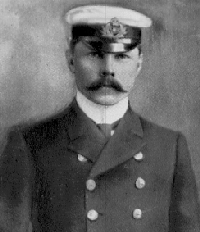
Third
Officer Herbert John Pittman* (1877-1961)
Third
Officer Herbert John Pittman was born on November 20th,
1877 in the village of Sutton Montis, Somerset, England. He joined
the White Star Line in 1906 as Fourth Officer. Third Officer
Herbert John Pittman passed away on December 7th, 1961 aged 84 as
a result of a subarachnoid hemorrhage. He was interred in
the Parish Churchyard of Pitcombe, Somerset.
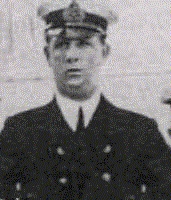
Fourth
Officer Joseph Groves Boxhall* (1884-1967)
Fourth
Officer Joseph Groves Boxhall was born on March 23rd,
1884 in Hull, Yorkshire, England. He joined the White Star Line in
1907 as a Junior Officer. Fourth Officer Joseph Groves Boxhall
died on April 25th, 1967 at the age of 83. He was cremated, on
June 12th and his ashes were scattered over the position he had
calculated that the Titanic had gone down.

Fifth
Officer Harold Godfrey Lowe* (1883-1944)
Fifth
Officer Harold Godfrey Lowe was born in 1883 in Wales. He
joined the White Star Line only fifteen months prior to
joining the Titanic. Fifth Officer Harold Godfrey Lowe did
survive the sinking. He died May 12th, 1944.
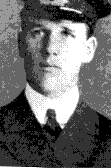
Sixth
Officer James Pell Moody (?-1912)
Sixth
Officer James Pell Moody was born on August 21st, in
Scarborough, England. He joined the White Star Line as a Junior Officer. Sixth Officer James Pell Moody did not survive
the sinking. There is a memorial plaque bearing James Pell Moody's
name in the Church of St. Martin on the Hill, Scarborough. It
bears the verse: "Be Thou Faithful Unto Death and I Will
Give to Thee a Crown of Life." There is also an altar
set at St. Augustine's Church in Grimsby that is memory of James
Pell Moody.

Lookout
Frederick Fleet* (1887-1964)
Mr. Frederick
Fleet was born in October 1887. He never knew his father and
his mother abandoned him and ran away with a boyfriend to
Springfield, Massachusetts never to be heard from again. Frederick
was raised by a succession of foster families and distant
relatives via orphanages and Dr. Banardo Homes until the
age of twelve when he was sent to a training ship, where he
stayed until he was sixteen. In 1903 he went to sea as a deck
boy, working his way up to Able Seaman. Before
signing-on the Titanic he had sailed for over four years
as lookout on the 'Oceanic'. His address was given as Norman Rd, Southampton. As a seaman Frederick Fleet earned five
pounds per month plus an extra 5 shillings for lookout duty. And
it was as a lookout that Fleet joined the Titanic
in April 1912.
From
June 1912, Fleet served briefly as Seaman on the White
Star liner Olympic. He found that the White Star
Line looked at the surviving officers and crew as embarrassing reminders of the recent disaster and he left the
company in August 1912. For the next 24 years Fleet
sailed with Union-Castle and various other companies,
finishing with the sea in 1936. Ashore, he worked for Harland
and Wolff as a shipbuilder, and later was the shore
Master-at-Arms for Union-Castle Mail Steamship Co.
As he moved into old age, he sold newspapers on a street corner
in Southampton.
On
December 28th, 1964, Fleet's wife died. Her brother, with whom
the couple lived, then evicted Fredrick, and in a state of
despondency, he committed suicide two weeks later, his body being
discovered on January 10th, 1965. He was buried in an unmarked
paupers grave at Hollybrook Cemetery, Southampton. In 1993, a
headstone was erected through donations by The Titanic
Historical Society.
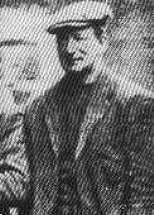
Lookout
Reginald Robinson Lee* (1871-?)
Mr.
Reginald Robinson Lee of Threefield Lane, Southampton did
survive the sinking of the Titanic and was saved in lifeboat
#13. Lifeboat #13 (capacity 65 persons) was
launched from the starboard side at 1.40 a.m. under the command
of Leading Fireman Fredrick Barrett. It contained 60 or
62 people (mainly men). Lifeboat #13 drifts underneath
lifeboat #15 as it is being launched. Leading Fireman Fredrick
Barrett tries to cut the ropes to free lifeboat #13. It
drifts out of the way at the last minute as lifeboat #15
lands in the water. Lifeboat #13 arrived at the Carpathia
at about 4.45 a.m. on the morning of April 15th, 1912.
At
the British Inquiry, Lee tried to claim that there was a haze
over the water at the time of the impact with the iceberg.
Lookout Fleet, Second Officer Lightoller,
Fourth Officer Boxhall and Wheel-Master Hichens
all denied the existence of a haze, and the matter was written
off as "wishful thinking".

First
Radio Operator John George Phillips (1888-1912)
Firs
Radio Operator John George Phillips was better known as "Jack"
or "Sparks" (because he morsed so fast), was
born and raised in Godalming - (Surrey) England - on April 11th,
1888. He had served as a telegraphist in the Godalming Post
Office, afterwards he joined the Marconi School at Liverpool.
His first wireless appointment was on the ship the Teutonic,
after which he was appointed on the Mauretania, the Lusitania
and the Oceanic. From there Phillips was
transferred to the Titanic. Phillips joined the Titanic
at Belfast. Phillips died in the disaster, a few days after his
25th birthday. Because he had been awake the previous night
repairing the equipment Phillips was too exhausted to
survive in the icy water. He died of hypothermia on or near
Collapsible Lifeboat B, his body was never recovered.

Second
Radio Operator Harold Bride* (1890-1956)
Harold
Bride was born in 1890 at Nunhead, England. He joined the Marconi
School and received his first appointment in July of 1911.
He first worked aboard the Hoverford and then on the Lusitania.
Bride joined the Titanic at Belfast. Harold Bride survived
the sinking of the Titanic in Collapsible Lifeboat B. He
kept a very low profile in the years following the Titanic
disaster. World War I found him as a wireless operator on the
tiny steamer, the Mona's Isle. He later embarked on a
career as a salesman. In the 1920's he married Lucy Downie.
The couple moved to Scotland and had three children. Bride was an
avid church-goer and rarely spoke of the Titanic. He died
of bronchial complications in 1956.
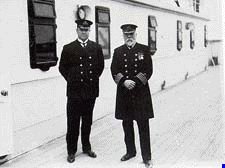
Chief
Purser Herbert Walter McElroy (1870-1912)
(Seen
here with Capt. E. J. Smith)
Mr.
Herbert Walter McElroy, age 37, was born in Liverpool in
1875. Prior
to joining the Merchant Navy in 1892 he attended the Roman
Catholic Priory in Bodmin, Cornwall for a training to become a
Roman Catholic priest. He did not finish the training however. McElroy
was married to Barbara Ennis. The couple had their three children
and they lived at Polygon House, Southampton. He had served for
three years on board the troopship Britannic during the Boer
War, he also served on the Majestic and was purser on
the Olympic until transferred to the Titanic. He
signed on the Titanic on April 9th as Chief Purser for
which he was paid at the rate of £20 per month. On the fateful
night of April 14th - 15th McElroy and his staff retrieved valuables from the safes and encouraged passengers to hurry to
the Boat-Deck, he told the Countess of Rothes "I'm
glad you didn't ask me for your jewels as some ladies have".
Later he was forward where Collapsible Lifeboat C had been fitted
to the lifeboat davits. Two men jumped into the boat and McElroy
fired his gun twice into the air as First Officer Murdoch ordered
them out.
With the water at
C-Deck, and rapidly rising - according to eyewitnesses - McElroy
stood with Dr. William O'Loughlin (Titanic's
Surgeon), Dr. Edward Simpson (Titanic's Assistant
Surgeon), Purser Reginald Barker and Second Officer Herbert
Lightoller. Minutes before the sinking McElroy was seen standing
on the Boat-Deck beside mail clerk William Logan Gwinn.
Both men died in the sinking. McElroy's body was recovered from
the sea by crew members of the Mackay Bennett. Among the
effects were keys tagged "Linen Locker No. 1 C- Deck"
and the address: Miss McElroy, Layton, Spottisbury,
Dorset. The body was not immediately identified as that
of Chief Purser McElroy and was buried at sea.
NO. 157. —
MALE. — ESTIMATED AGE, 32. — HAIR, DARK.
CLOTHING - Ship's uniform; white jacket; ship's keys; 10 pence;
50 cents; fountain pen.
CHIEF PURSER. — NAME — HERBERT W. McELROY.
 |
The Band of the Titanic was hired be Messers C. W.
and F. N. Black of Liverpool. They continued to
play throughout the disaster on the boat deck helping people calm their
nerves. "Towards the end, they played Nearer my God to Thee"
said some survivors and some said they played Ragtime tunes. Whatever
they played...they went down with the Titanic and died a heroic death.
From Left To Right
Top Row:
Brailey, Theodore
- Pianist - age ? &nnbsp;
Bricoux, Roger - Cellist - age ?
Middle Row:
Taylor, Percy, C. - Cellist - age ?
Hartley, Wallace Henry - Bandmaster - age 33
Krins, George - Violist - age 23
Bottom Row:
Hume, John (Jock) Law - First violinist - age 21
Clarke, J. Fred C. - Bass violist - age 34
Not in Picture:
Woodward, J. W. - Cellist - age 32
|